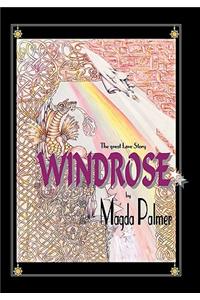Year: 2006, Duration: 35 min. ,
Instrumentation: Symphony orchestra and 5 voices : 3D1.2, 2D1.1,2,2/4,2,3,1, timp, perc (3 players), harp, str , Boy soprano, soprano, mezzo-soprano, tenor, baritone,
Piccolo, 2 flutes, 2 oboes (doubling cor anglais), 2 clarinets in B flat, 2 bassoons, 4 horns in F, 2 trumpets in B flat, 2 trombones, bass trombone, tuba, timpani, percussion (3 players-bass drum,snare drum,cymbal,tam-tam and wind-chimes)), harp, strings. ,
Difficulty: Advanced — The timpani part is difficult but could be divided between two players if necessary. ,
Dedication note: Composer’s dedication: To the memory of my father Les Dugdale
Commission note: Commissioned by Darwin Symphony Orchestra.
First performance: by Darwin Symphony Orchestra, Martin Jarvis — 27 Sep 09. Darwin Convention Centre, Darwin, Northern Territory
Available through The Australian Music Centre Click here for the link to The Australian Music Centre
This work is based on the epic poem, WindRose by Magda Palmer. The poem, which is in rhyming couplet, tells of the love between the Wind of our earth, and a Paper Bird. The Bird’s devotion is founded on his absolute reliance on the Wind for mobility, and the Wind finds ‘purpose-to-life’ in her love for the Bird.
However, the original magical balance in the relationship ends when the Bird becomes ‘lost’. Distraught, the Wind searches for her Bird, eventually finding him in a cave where she learns of his fate: he is trapped in a ‘net’ of his own making – self-indulgence and seduction by the trivial aspects of life. The Wind in turn becomes trapped, a victim of her intense grief, thus threatening the very existence of the Earth who is dependent on her powers.
A farming family become aware of the impending tragedy facing the planet when their young son finds the grieving Wind. He leads his family to where Wind and Bird are trapped within the cave. After hearing their story, the boy intervenes to set the Paper Bird free of his bonds, and so, Wind and Bird can love again and the Earth is saved from the destruction that nearly results from pure self-indulgence – both by material and element.
This musical adaptation by Cathy Applegate uses text taken from the poem and was developed with close collaboration between composer and poet. It alternates between songs and dramatic narration and may fit within the broadest definition of opera. In this work, the five soloists tell the story – the Boy (boy soprano), Mother (mezzo-soprano) and Father (baritone), along with the Wind (soprano) and the Paper Bird (tenor).
Click here for a link to Magda Palmer’s illustrated poem WindRose
Synopsis:
The work falls into three main parts (total duration – 35 minutes)
Part 1 (11 min) Tells of the boy’s discovery of the Wind trapped in a cave. The boy’s family reflect on the fact that without the wind, the planet Earth cannot survive. The boy convinces his parents to come and see, and the Wind sings of her love.
Part 2 (11 min) The Wind’s story is told. She was once a rebellious force that was punished by the celestial lords of the Zodiac and doomed to roam the Earth lonely. And so she did, until she heard the singing of her Paper Bird.
Part 3 (13 min) Tells of the passionate love that develops between Wind and Bird. The bond between the lovers seems unbreakable, and yet, one day, Wind finds that her Bird is missing. A distressed Wind searches and eventually discovers Bird in a cave. She soon learns of his predicament – he has been snared in a net of his own making – self-indulgence and the lost perspective of what is truly important in life. The Wind succumbs to intense grief and is, in turn, trapped by her emotions.
But the boy and his family arrive and bring hope. Indeed the boy has the power to free the Bird, and so the lovers are reunited, and the Wind once again blows across the face of the Earth.
A Wind Rose was first used by sailors in the 13th century on their navigational charts and consisted of an eight point flower-like design marking the major winds. Meteorologists today use a Wind Rose to find frequency, strength and direction of the prevailing wind.
Magda Palmer was working as a Newsreader in Scotland, when on her way home she saw a boy racing across the wild moor. Concerned, she stopped her car as he crossed the road. The boy told her that he’d found the wind trapped in a cave. From this experience came the inspiration for the poem WindRose and for the song Highland Lament.
Subsequently, Magda has published the poem with her own illustrations.
In 2006, Magda approached the artistic director of the Darwin Symphony Orchestra, Martin Jarvis about the possibility of setting the poem to music. He, in turn, approached local composer/author, Cathy Applegate. Cathy edited the poem and created a new work for the Darwin Symphony Orchestra.
